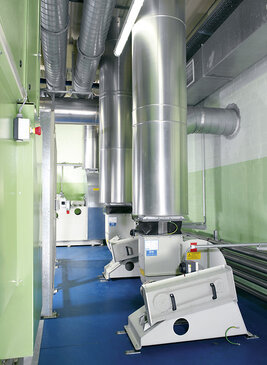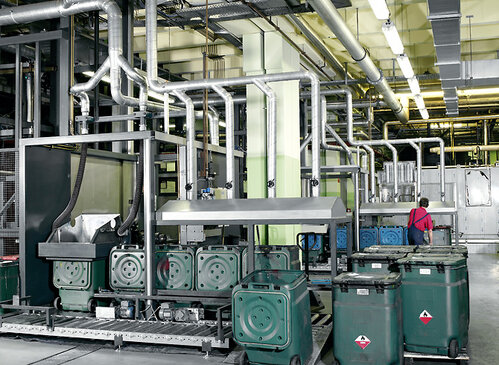Contact
You have any questions?
Or want us to call you?
By using our online form your questions and requests will be forwarded to the responsible contact person.
...to the form
Fresh Air in the textile industry
Pneumatic conveying plant with exhaust, dust extraction and ventilating plants
Consumption in Europe is stagnating; production and machine sales figures are sinking. Those who can, are investing, modernising and making their production facilities more cost-effective. Air handling technology is directly involved in higher productivity and increased economic efficiency. It is not, however, easy to integrate new and better systems into existing production plants. But, it can be done – says Venti Oelde.
“It even works very well, if not completely without difficulties and challenges. And provided that it is possible to call on the competent support and know-how of specialists”, confirms Sven Kühmel, graduate engineer, engineering and production technology manager at Mewa Textil-Mietservice Bottrop GmbH. The fact that processes and energy consumption and costs can be improved is, he finds, a welcome result. Furthermore, he considers it to be a logical after-effect that safety and environmental topics are satisfied at the same time, thus meeting future European standards in good time and at reasonable cost. Optimization of the air handling technology in Bottrop also follows this principle.
Air as profitability factor
“Air is indispensable as process medium when exhausting solvent, oil, petrol or chemical product vapour or when removing foreign matter or pollutants. However, air is also very important, even for washing, drying, conveying and sorting plants as well as for the filtering out of fibers. Modern air engineering provides efficient ventilation of workshops and selected process stations. Air is needed for the pulses to clean filter bags and ensures successful fire, explosion and environmental protection”, explains Sven Kühmel. “Specific conditions must be fulfilled to make the complete engineering process functional and cost-effective. This includes the well-directed supply of conditioned air, ideal laying of ducting, aerodynamically efficient transitions and exhaust air openings, etc. Not to forget the high-efficiency fans and reliable control systems for temperature, humidity, fresh air supply. Finally, there are the filtration and exhaust air treatment.” Fluff, dust, chips, grease, solvents and all substances which pose a health hazard must be separated or efficiently exhausted in accordance with the European ATEX guidelines in a way which prevents the occurrence of explosions, and disposed of in compliance with legal requirements.
A modernised cloth cleaning system has been in operation in Bottrop for a while now. Annually about 130 million cotton wipers 40 x 40 cm are washed, checked, packed and once again made available. There was only six months for the removal of the old plants and installation of the new interconnecting double line, stretching over two floors. Despite problems posed by the building, a long operational standstill could not be tolerated. Detailed advance planning and expert engineering were needed to bring a fast and successful conclusion to the work. Although serious obstacles arose while the alterations were being carried out, the project was concluded within the time limit and the calculated range of functions of the new plant was attained. Venti Oelde was significantly involved at every level.
Mewa gave preference to Venti Oelde, because, true to the motto “everything from a single source”, one partner for a range of differing equipment is best, provided he possesses all the required skills. Reinhard Hasenpflug, project manager in the engineering division dust collection and conveying at Vent Oelde, was responsible for coordination and communication between the participants. He considers that Venti Oelde’s know-how and their wide range of services was the reason that they were awarded the order to supply the air handling plants in Bottrop and also have the opportunity to submit suggestions for international Mewa projects. He explains that the complexity of the project did not allow for compartmentalised solutions. “The customer’s changes of mind, extremely cramped conditions inside the building and surprises for which nobody was prepared, meant that occasionally unknown territory had to be explored.” But everything went as planned: Venti Oelde calculated and planned a total of 13 functional units. The engineers designed air handling equipment and systems to exhaust, clean, filter, replace and convey. These included modern fan technology, exhaust plants for driers, for the filters in the drier, for heating elements and vat tipping stations. There followed dust collection equipment, ventilating and air replacement plants. A closed loop plant is responsible for transport to the wiper separation system. Also included in the contract were air transfer between the floors and rooms and ventilation of the switch cabinet assemblies.
Some of the solutions could be taken from modular systems; others were achieved through customizing and making to measure. Final erection on site, ducting manufacture and installation together with commissioning in cooperation with the customer concluded the work. Obstacles, such as the necessity of delivering equipment through the partially opened roof, demanded an imaginative response. But even tricks required to install the plant on ceilings and floors with only limited load-bearing capacity did not cause the modernizers to deviate from their course. But all the same: “These were rocks which had to be negotiate, taking up more time,” remarked Reinhard Hasenpflug. “Finding ways to separate and clean the fluff in filters became an engineering challenge and also took time. When damp it cakes and sticks together, when dry it interlaces and floats as light as a feather on the smallest air cushion. This means that it is difficult to filter.” Venti Oelde, however, managed to find an optimum solution, achieving a residual dust content of < 0.2 mg/m³ which is extremely satisfactory. Contrary to the drum filters which are widely used in the textile industry, Venti installed for Mewa special bag filters with double-pulse cleaning. They are particularly compact, efficient, cost-effective, require little maintenance and can easily be adapted to individual requirements. Apart from the inner pulse cleaning, they also possess filter bags and so-called pulse nozzles on the dust-laden air inlet side. At set intervals compressed air shoots out of quick-opening valves (0.1 s pulse). This compressed air entrains secondary air, loosening dust, fluff, dirt particles, etc. and blows these in the direction of the discharge zone. The process is helped by the force of gravity. The filtered air can be returned to the workshops without secondary filtering or requiring further equipment. The performance data of this Venti Oelde engineering amazed and convinced a large number of other textile factory owners.
Air Performance
All participants were drawn into consultation during the modernizing work since various interface points and cross-linking had to be combined for the overall control of the plant. On conclusion of the work Sven Kühmel praised the imaginativeness, know-how and flexibility of all those who had worked on the project. Of course, all plants fulfil their duty with regard to fire prevention, explosion proof design and environmental protection. A further advantage: Venti Oelde was able to carry out modifications in the control engineering quickly and easily via the existing modem connection without having to send engineers to the site. Including the ambient air, Venti Oelde engineering now moves about 175,000 m³ air/h. The installed motor output is approx. 160 kW. High-efficiency fans suitable for inside gas hazardous zone 1 and for temperature load up to 150 °C convey the solvent-laden exhaust air to the pollutant disposal system. The Venti Jet bag filters (they work in a single filter stage with very low pressure loss) permit the filtered air to be returned directly to the workrooms because of te extremely low residual dust content. Last, but not least, the pneumatic wiper conveying plant delivers up to 2,400 cleaned and dried cleaning wipers in batches within 30 s to various delivery points. Air becomes a factor of reliability, efficiency and productivity. The service of the Mewa wiper cleaning system is imposing and has to function smoothly. Plant shutdown would have disastrous consequences. “We are certainly not an easy customer for our design and engineering partners”, remarked Sven Kühmel. “But”, added Reinhard Hasenpflug, “a supremely competent and forward-looking partner who consistently expects, encourages and recognizes everyone’s best efforts.”
Information – The Bottrop Plant
Even specialists rub their eyes
An average of 11 million machine wiper cloths a month end up in special containers and are collected by Mewa from their clients. Different coloured lids identify the content (contaminated with chips, oil, grease, solvent). The wipers are cleaned in Bottrop in two laundering lines, the personnel working in two shifts. Wipers contaminated by solvent are specially treated. Venti exhaust air hoods installed above the tipping points and direct exhaust on the tipping devices capture the gaseous pollutants. The other wipers are passed to the washing machine via a device to shake off chips and a rotary screen to separate solids. In both industrial washing machines the wipers are soaked, boiled, rinsed and re-rinsed in a 300 s cycle (washing cycle 65 min). In one washing cycle there are on average 2,100 wipers (clean weight about 85 kg). After passing through the mangle, intermediate storage and continuous drier, the batch arrives at the Venti closed loop system. This pneumatic delivery system conveys the wipers to the separating plant, where they are separated from one another. Quality control, selection and picking machines are placed at the end of the line. The wipers finally reach the automatic and manual packing stations. Laundry peripheral plants include a waste water treatment facility, the boiler house and the compressed air generator as well as an exhaust air treatment plant with thermal pollutant disposal in accordance with legal obligations.
Information – Company Profile
No longer is Ventilatorenfabrik Oelde GmbH, the official name, only manufacturer and supplier of industrial and high-tech fans. The medium-sized company, now well-known in many branches as plant and component builder, offers a wide range of products and services: air, vapours and gases, dust and air-borne solids are exhausted, conveyed and filtered. The available products range from traditional air-handling and filtering engineering to bio-filters and devices for recycling and environmental protection. Standard and individual realisation of solutions, including those for the textile industry, have made the company, its specialists and “specialities” well-known internationally.




